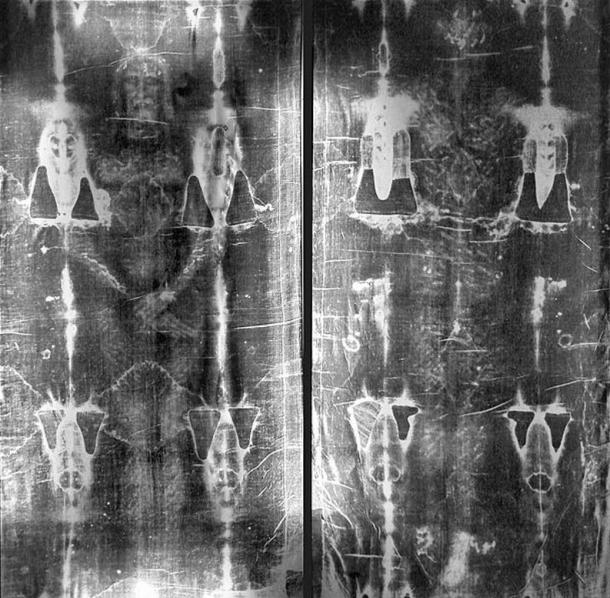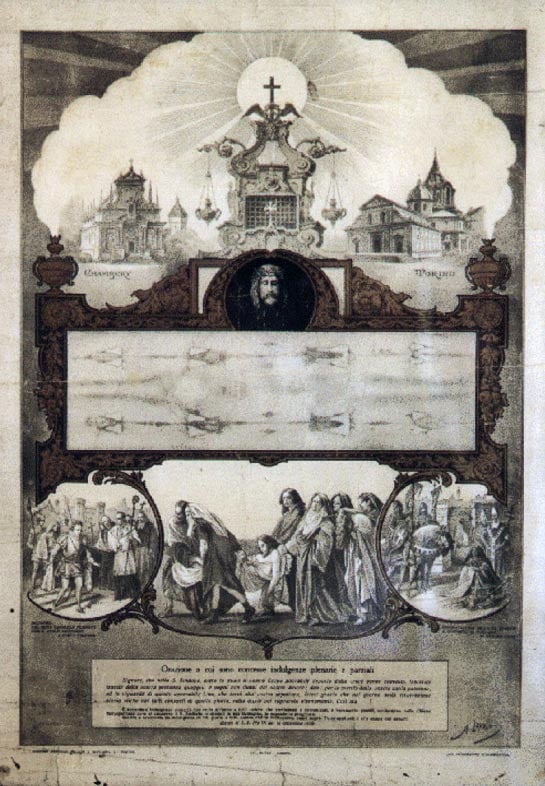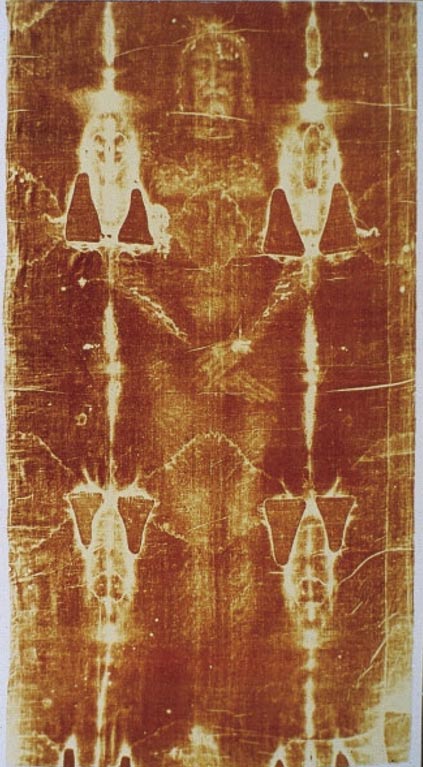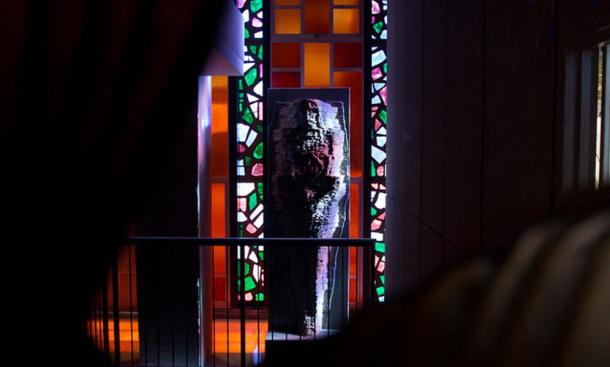The Shroud of Turin: Controversial Cloth Defies Explanation as Study Shows it Has DNA From Around the World
Believed by many to be the burial cloth of Jesus of Nazareth, but held only as a religious article of historical significance by skeptics, the Shroud of Turin has captivated scholars and scientists alike due to its mysterious nature. New DNA tests add to the body of research that only serves to highlight the strange, unexplained origins of the shroud.
The cloth, a pale sheet of woven fabric approximately 14-feet (4.5 meters) –long, might be considered unremarkable save for the distinctive reddish-brown markings on its front and back. The image of a prone man with hands folded can be made out on the cloth, with both the front and back views of the head meeting neatly at the middle of the sheet, suggesting it was folded over the front and back of a naked body in death. Countless horrible wounds to the body are revealed through the images on the fabric, from slashes to gouges, piercings and welts. These images strongly indicate to proponents the evidence of crucifixion and the Biblical description of the death of Jesus.

The full length of the Shroud of Turin. Scientists and scholars cannot resolve the mystery of the shroud. (Public Domain)
The Hidden History of the Shroud
Historical record can place the shroud in the late 1300s. Scholars debate its existence previous to 1390, describing the period before that as “very murky territory.” Even during the middle ages there was disagreement over authenticity of the cloth, with written claims at the time between church officials suggesting it was a forgery. However, historians raise the possibility that several such ‘shrouds’ were making the rounds at the time, and forgery claims might have had nothing to do with the cloth found today in the cathedral in Turin, Italy.
Since the 15th century, the existence of that shroud is well documented. It was deeded to the House of Savoy in Italy in 1453, and suffered damage in a fire. Patches and repair-work have been done at various times on the artifact. It was set in a chapel in the 17th century, but it wasn’t until 200 years later that it was put on public display, and first photographed.

Full length negatives of the Shroud of Turin. (Public Domain)
It was these photographs which elevated the cloth from relic to sensation. The photos were not remarkable in and of themselves, until viewed in the reverse negative, whereupon a detailed image of a wounded, bearded man became clearly visible. It had previously been suspected that the stains and images were painted on the linen by an artist at some point in its history, but the discovery of the detailed body image found embedded within the fabric drastically rewrote theories, and convinced many that the images were made through contact with an actual human corpse. Some Christians believe the image was transferred from Jesus’ body onto the cloth with a release of “divine light” or energy upon his resurrection.

A poster advertising the 1898 exhibition of the shroud in Turin. Secondo Pia's photograph was taken a few weeks too late to be included in the poster. The image on the poster includes a painted face, not obtained from Pia's photograph. (Public Domain)
If this was indeed the death shroud which encased the body of the historical Jesus of Nazareth, that would date the cloth to 30 AD, the biblical date of the death of Jesus. However, this dating is at odds with later historical record, as well as the modern scientific research on the artifact.
Scientific Examinations and Bombshell Revelations
A variety of tests have been carried out on the shroud since scientists were first allowed to examine it in 1969, including physical examinations, chemical analyses, and radiocarbon dating. Initial examinations led to the formation of an 11-member Turin Commission composed of scientists and advisors, and in 1977 the Shroud of Turin Research Project (STURP) was born.
Their findings, based on a gamut of rigorous tests, were reported in 1981, stating:
"We can conclude for now that the Shroud image is that of a real human form of a scourged, crucified man. It is not the product of an artist. The blood stains are composed of hemoglobin and also give a positive test for serum albumin. The image is an ongoing mystery and until further chemical studies are made, perhaps by this group of scientists, or perhaps by some scientists in the future, the problem remains unsolved."
The researchers found no sign of artificial pigments, meaning the image had been made by a real human body, but the question of how this had happened was not answered.
Radiocarbon 14 dating of the cloth revealed the shroud material dated to 1260–1390 AD, a bombshell finding, conflicting with the timelines of the death of Jesus. But critics alleged that the samples of fabric that were tested came from more recent patches, rather than the original cloth.
Adding to the wealth of strange findings on the enigmatic shroud, Italian researchers have now discovered that the cloth may have been made in India, and contains DNA from all over the world. By sequencing DNA from dust and pollen on the shroud, the origins of people and types of environments that the cloth has come into contact with have been revealed.
DNA analysis shows that the cloth may have been manufactured in India, and traveled the world before coming to Italy in the medieval period, giving rise to doubts about a medieval European origin.
Plant types revealed from DNA sequencing included horsetail, clovers, ryegrass and chicory pointing to origins from Asia, Middle East, or the Americas.
The Body Within
Stains indicate the proposed wounds and blood of the dead man. The images on the cloth are said to show a body damaged by cuts on nearly all surfaces; punctures, gouges and linear wounds can be seen. On one hand a large, round pierce mark is visible, and similar large puncture wounds can be seen in the feet.

The renowned Shroud of Turin, religious relic and mysterious artifact. (Public Domain)
The man’s bearded face is interpreted to be swollen and misshapen from severe beatings. Stains from blood are seemingly everywhere, especially near the area of the face and both arms.
The Question of Questions – How?
For all the scientific tests, no good answers present themselves on how the image in the shroud came to be, save, as believers would have it, a miracle. It has been determined the images are not painted on, but are imbued within the linen, and numerous attempts have been made to recreate the images, and to reproduce the unusual penetration of the color into the fabric, but have all fallen short. Physicist Paolo Di Lazzaro and leading expert on the phenomenon of the shroud calls this “the question of questions”: how was the image produced?
Di Lazzaro and colleagues used state-of-the-art lasers to direct short, intense bursts of ultraviolet light on raw linen to try to replicate the shroud’s images. In the end they were not successful in matching the shroud’s qualities, nor even could they reproduce a whole human figure. Regardless of the age of the cloth, science cannot duplicate The Shroud of Turin. How was this artifact created so many years ago?
“It is unlikely science will provide a full solution to the many riddles posed by the shroud. A leap of faith over questions without clear answers is necessary—either the ‘faith’ of skeptics, or the faith of believers,” Di Lazarro recently told National Geographic.
The cloth’s authenticity has not been officially declared by the Catholic Church, and it has only been described as a “mirror of the gospel”, and even a “distinguished relic” by Pope John Paul II. Nevertheless, the church encourages devotion to it, and the cloth has been protected and venerated by the faithful for centuries. It now sits on display under bulletproof glass in an airtight, environment-controlled case in Turin, northern Italy where it is guarded by cameras, drones, and police.

3-dimensional model of the Shroud of Turin imprint. (Flickr/CC BY 2.0)
Science may be closer to the origins of the shroud, or its travels since the Middle Ages, but researchers seem to be no closer to explaining the true nature of the religious relic. Philip Ball, former editor of science journal Nature hinted at the shroud’s enduring challenge: “it's fair to say that, despite the seemingly definitive tests in 1988, the status of the Shroud of Turin is murkier than ever. Not least, the nature of the image and how it was fixed on the cloth remain deeply puzzling.” This puzzle is still unresolved decades later, and so secures the Shroud of Turin as one of the more controversial and inexplicable relics in history.
Δεν υπάρχουν σχόλια:
Δημοσίευση σχολίου
NO COMMENTS!